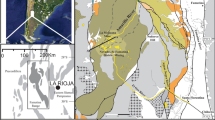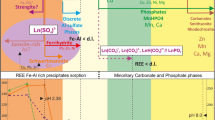Abstract
Acid mine drainage (AMD) with a minimum pH of 0.52 was recorded at Iron Duke mine near Mazowe, Zimbabwe during an investigation of the environmental geochemistry of mine waters in the Greenstone Belts of Zimbabwe. Hydrochemical data for waters emanating from the Iron Duke waste-rock pile indicate their super-saturation with respect to Fe and SO4 2–. Extremely high dissolved concentrations of Al, Zn, Cu, Co, Ni, V, Cr, Cd and As also prevail. Substantial losses of metals from solution occur within 400 m of the AMD source through the precipitation of crystalline sulphates, principally melanterite. Further downstream, hydrous oxide precipitation forms the dominant mechanism of metal attenuation in waters characteristically under-saturated with respect to Fe sulphates. Speciation and saturation index data generated using the equilibrium model WATEQ4F, suggest that such codes have broad utility for generic prediction of the mineralogical contraints on metal mobility in acute AMD systems. Major discrepancies between modelled and empirical hydrochemistries are, however, evident for super-saturated waters in which the kinetics of Fe precipitation are slow, and in which total ionic strengths markedly exceed their theoretical maximum.
Similar content being viewed by others
Author information
Authors and Affiliations
Additional information
Received: 28 August 1998 · Accepted: 7 December 1998
Rights and permissions
About this article
Cite this article
Williams, T., Smith, B. Hydrochemical characterization of acute acid mine drainage at Iron Duke mine, Mazowe, Zimbabwe. Environmental Geology 39, 272–278 (2000). https://doi.org/10.1007/s002540050006
Issue Date:
DOI: https://doi.org/10.1007/s002540050006




